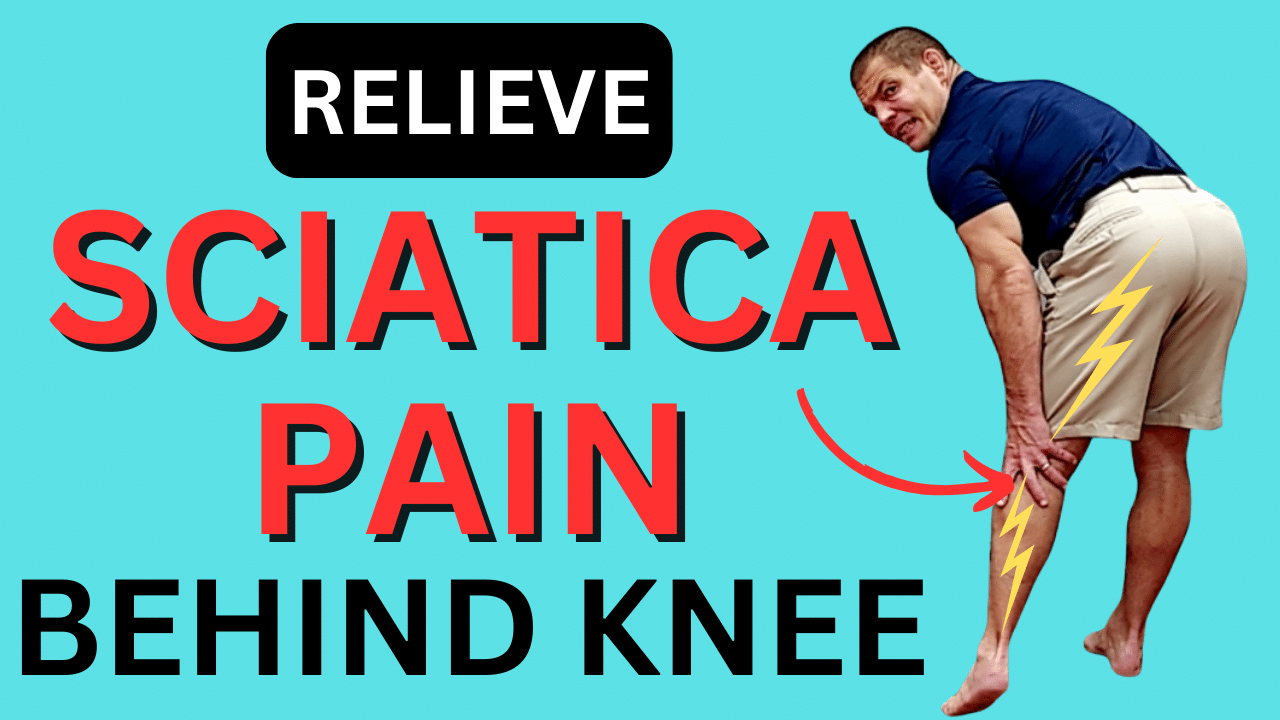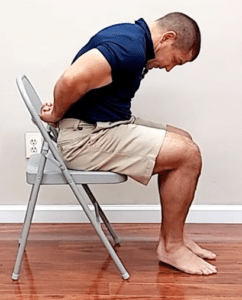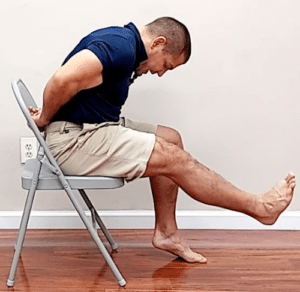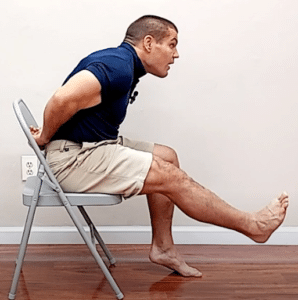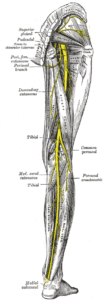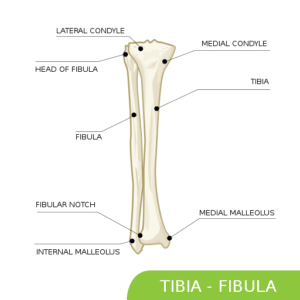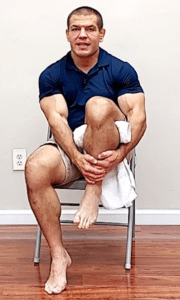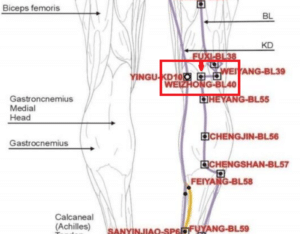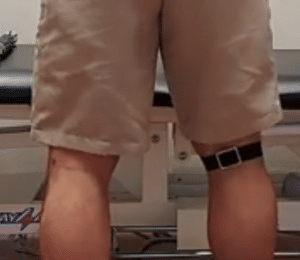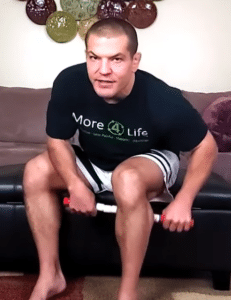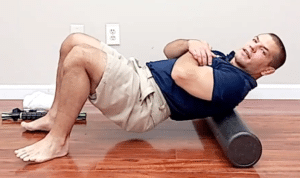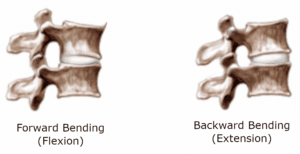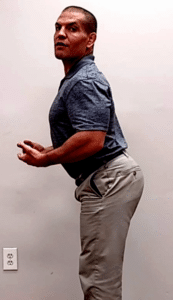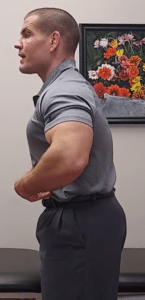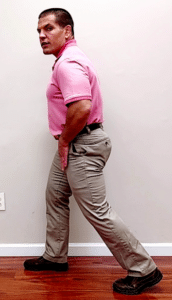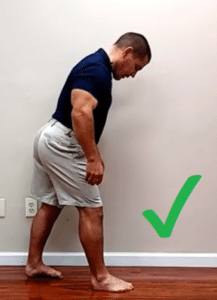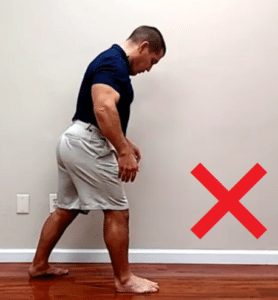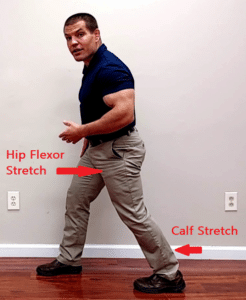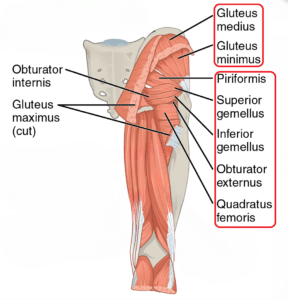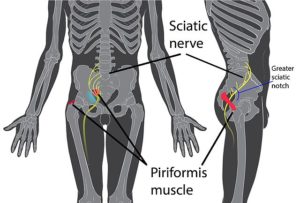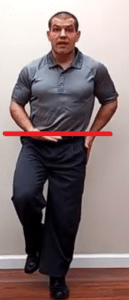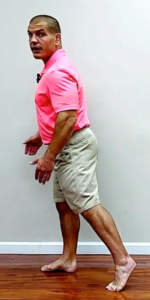Do You Get Sciatica Pain Behind The Knee When Standing Or Walking?
Learn 5 quick fixes for sciatica pain behind the knee plus 5 exercises for long-term relief that you can do in just minutes per day. Click the play button to watch the video.
In this post, you'll learn:
- Can Knee Pain Cause Sciatica? Or Does Sciatica Cause Knee Pain?
- Symptoms of Sciatica Pain Behind the Knee
- Test For Sciatic Nerve Pain Behind Knee
- 5 Quick Fixes For Sciatica Pain Behind The Knee
- 1. Sciatic Nerve Glides
- 2. Common Fibular Nerve Compression Behind The Knee
- 3. Tibial Nerve Acupressure (BL-40 / UB-40)
- 4. Massaging Your Calves
- 5. Foam Rolling Your Thoracic Spine
- 5 Exercises For Long-Term Relief Of Sciatica Behind The Knee
- 1. Do a pelvic tilt when standing
- 2. Stretch your hip flexors
- 3. Stretch your calves
- 4. Balance on one leg
- 5. Improve your walking pattern
- Conclusion
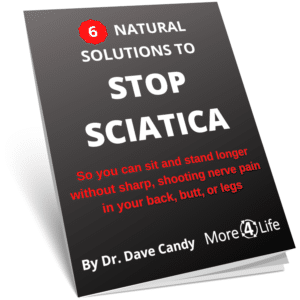
Can Knee Pain Cause Sciatica?
Or Does Sciatica Cause Knee Pain?
If you're having sciatica pain behind the knee, it can sometimes feel like the pain is starting in the knee and radiating outward away from the knee.
At other times, it feels like pain radiates from the buttock down to the knee.
So which is the cause?
First of all, it make sense to determine if your the pain behind your knee is caused by sciatica or something else.
After all, pain in back of your knee can also be caused by:
- stiff calf muscles
- stiff hamstring muscles
- meniscus tears
- Baker cysts
Symptoms of Sciatica Pain Behind the Knee
Some symptoms that may indicate that you're having sciatica pain behind your knee include:
- shooting pain that radiates from your butt down to your knee or from your knee that seems to shoot upwards.
- numbness or tingling in your legs
- "burning" pain behind the knee
- a history of back pain or buttock pain, particularly on the same side as your knee pain
Those are all possible indications that your knee pain may be caused by sciatica.
Test For Sciatic Nerve Pain Behind Knee
Along with these symptoms, there's also a test that you can do to help determine if the pain behind your knee is being caused by sciatica.
Furthermore, this test leads directly into the first treatment.
The Slump Test
This test is aptly named because to do it, you sit in a chair in a slumped over position.
Clasp your hands behind your back and bring your chin down toward your chest.
Now straighten knee knee of your painful leg just up until the point where you feel pain behind the knee.
If you can straighten your knee all the way without pain, then pull your toes up towards you.
Wherever you start having pain during this test, stop moving your leg and hold it there.
Note the intensity of the the pain.
Next, lift your head upwards.
If that changes your pain, particularly if it makes it better, that's a good indication that your nerves are involved.
That's because your calf muscles and your hamstrings don't attach to your head.
However, your nervous system is continuous from your head all the way down to the tips of your toes.
If you get a positive slump test, that's a good indication that your sciatic nerve may be causing your knee pain.
So then, how do you treat it?
5 Quick Fixes For Sciatica Pain Behind The Knee
I mentioned that the first treatment is very much like the test.
1. Sciatic Nerve Glides
Start in the slump test position like this and then straighten one leg up just to the point where you start having symptoms.
Then bring it back down and repeat.
There are 2 different ways that you can do these nerve glides.
You can do a "slider" where you move your head up at the same time as you bring your foot up and vice versa.
Supposedly, that's a less aggressive version because you're really just kind of sliding the nerve like dental floss through your spine and through your leg without adding tension to it.
However, if you also happen to have some neck pain or you get dizzy when you look up, that may not be the best option for you.
Another alternative that works pretty well is just moving the leg without moving the head.
This is referred to as a "tensioner". It does put a little more tension on your nerves, but as long as you don't push through pain, it sill works well.
Why do nerve glides help sciatica pain behind the knee?
The really the reason that these sciatic nerve glides work is that they get your nerves to move back and forth through your spine and legs.
Nerves need three things to be healthy:
- space to move
- movement
- blood flow
When you do nerve glides, you get that movement and blood flow.
But what do you do if the nerve is compressed somewhere?
Well, that's what the other four treatments are going to address.
2. Common Fibular Nerve Compression Behind The Knee
Any nerve compression from your spine to your foot can affect your sciatic nerve. However, since we're talking about sciatic nerve pain behind the knee, I'm going to first address areas where it could be compressed behind the knee.
First though, you should understand a little bit about the anatomy of your sciatic nerve.
Sciatic nerve anatomy
Your sciatic nerve is made up of the L4-S2 nerve roots from your lower back and then runs through your buttock, down the back of your leg, and into your foot.
You can see that just above the knee, the sciatica nerve splits into two branches:
- a common fibular (peroneal) branch which goes along the back-outer side of the knee
- a tibial branch which goes right down the back of the knee and calf.
The common fibular nerve can get compressed is behind a joint in your knee called the proximal tibiofibular joint.
It's where the small bone in your lower leg, the fibula, joins with the big bone, the tibia.
If that joint isn't moving properly, it can compress the fibular or peroneal branch of the sciatic nerve.
In the best-case scenario, that joint doesn't move very much, so it's really hard to test it's mobility on yourself.
Fortunately though, the treatment is pretty easy and low-risk. So, in this case, the treatment is actually the test.
Treatment for common fibular nerve pain behind the knee
To do the treatment, take a rolled-up towel and wedge it behind your knee.
You can do this sitting in a chair or you can do it lying down.
Get the towel deep in the knee crease, right behind your fibular head.
Then grab your shin with your hands and pull your knee into as much bend as you can comfortably.
What this does is it uses the towel to push that fibular head forward. If it's stuck and not moving properly, this will help get it moving and you'll likely feel immediate improvement in your back of knee pain.
If it doesn't help, that probably wasn't the problem in the first place, but it's an easy enough treatment to try, and there's fairly low risk that it will make you worse as long as you only bend your knee as far as you can comfortably.
3. Tibial Nerve Acupressure (BL-40 / UB-40)
Moving on to the other branch, the tibial nerve, that runs down the back of the knee.
It runs right through the soft spot in the back of the knee called the popliteal fossa.
There's a well-known acupressure or acupuncture point back there called the bladder-40 (BL-40) point or the urinary bladder-40 (UB-40) point.
Putting pressure right on that area that's right over the tibial nerve can often help relieve sciatica.
Hold a gentle pressure for about 1.5-2 minutes.
Afterward, you can try doing the slump test again to recheck your symptoms. Or, just get up and walk around and see how you feel.
If you want an on-the-go option, there are also braces that you can use such as the Sciatica Relief Band by Tenex.
You strap the band around your knee as shown so that it puts a gentle pressure right on that bladder-40 point in the back of the knee. It can help make it a little bit more comfortable when you're up and moving around while walking.
Just make sure you don't put it on so tight that it's causing pain.
4. Massaging Your Calves
The next option is still for the tibial branch but further down in the calf.
If your calves are stiff, they can create pressure on the tibial nerve in your calf.
Use a muscle massage stick or a regular baking rolling pin to massage your calves.
Make sure to get check all areas of the calf - the back, inner side, and outer side.
Yansyi Muscle Roller Stick for Athletes ...
$9.15 ($9.15 / Count) (as of July 25, 2024 20:32 GMT -05:00 - More infoProduct prices and availability are accurate as of the date/time indicated and are subject to change. Any price and availability information displayed on [relevant Amazon Site(s), as applicable] at the time of purchase will apply to the purchase of this product.)
If you happen to notice an area that's a little bit more tender, spend a little bit of extra time there.
Again, you don't need to put so much pressure that you're causing yourself pain.
Ultimately, you will want to stretch your calves after doing this, but we'll get to that a bit later.
5. Foam Rolling Your Thoracic Spine
Finally, what about using a foam roller?
People commonly foam roll their hamstrings as a treatment for sciatic nerve pain behind the knee.
However, if your sciatic nerve is already irritated, often that just flares it up and makes it more irritated.
There are some good things that you can do with foam rollers though.
You don't actually treat the areas in the knee and thigh that hurt.
Instead, you work on the areas that don't hurt.
Remember, your nervous system is continuous from your head all the way down to your toes.
That means it runs through your upper and lower back. Using a foam roller is a really good way to loosen up your upper back.
Your sympathetic nervous system or your fight-or-flight system that run on either side of your thoracic spine.
Oftentimes it feels good to get that area moving a bit better. You may hear or feel a few pops when you're doing this, which isn't really the purpose, but it does often feel good.
Doing this can help calm your nervous system.
Amazon Basics High-Density Round Foam Ro...
$13.99 (as of July 26, 2024 10:01 GMT -05:00 - More infoProduct prices and availability are accurate as of the date/time indicated and are subject to change. Any price and availability information displayed on [relevant Amazon Site(s), as applicable] at the time of purchase will apply to the purchase of this product.)Just roll on the upper to mid-back though. Rolling the lower back usually isn't comfortable.
Another advantage of doing that type of exercise is that it helps your thoracic spine to extend a bit more.
If your thoracic spine is slumped over, then when you stand and walk, if you don't want to look down at the floor, you've got to straighten yourself up somehow.
That comes from arching at the lower back.
However, arching your lower back can pinch the nerve roots that make up the sciatic nerve.
That brings us to some of the longer-term strategies for getting your sciatic nerve to stop hurting.
5 Exercises For Long-Term Relief Of Sciatica Behind The Knee
1. Do a pelvic tilt when standing
When you stand with your lower back arched or extended, that narrows the spaces where the nerve roots of the sciatic nerve exit your back.
To decrease the arch in your lower back when you're standing, it is helpful to straighten up through the upper back so that you don't stand and walk hunched over. Think about lifting your chest to do this.
Additionally, rolling your pelvis underneath you go from an arch-back position more of a flattened back position.
This will likely feel strange at first, but if you practice it regularly when standing, it will start to feel more normal over time.
You don't have to make additional time in your day to do this "exercise". Just practice it whenever you happen to be standing. (i.e. in the kitchen or at the store)
2. Stretch your hip flexors
Stiff hip flexor muscles can also pull you into a forward pelvic tilt where your back is too arched.
Therefore, it's a good idea to stretch your hip flexors.
One way to do that is by staggering one leg forward and one leg backward.
Then roll your pelvis under like we did in the previous exercise, and then push your pelvis forward just until you feel slight stretch in the front of the hip.
Hold for about a minute.
3. Stretch your calves
I mentioned earlier that after you roll your calves with the rolling pin, it's a good idea to stretch them.
One way to do that is by staggering your feet as shown below. It helps to keep your arch domed on both feet as well.
Keep the arch lifted, toes pointed ahead, and then just lean forward keeping your heels on the floor.
You may notice that this position looks very similar to the hip flexor stretch.
If you want to be efficient and try to do both of those exercises at the same time. Start by doing the calf stretch and then just push the hips underneath you while having the pelvis rolled so you feel a stretch both in the front of the hip and the back of the calf.
That can save you a bit of extra time if you want to try to do both of those exercises at the same time. Stretch each leg for about 1 minute.
4. Balance on one leg
Strengthening the gluteus medius and minimus muscles on the side of your hip can also help sciatica pain behind the knee.
Your sciatica nerve runs underneath a muscle called your piriformis.
If your gluteal muscle aren't strong enough to balance your body on one leg every time you take a step, then the piriformis muscle can get stretched over the sciatic nerve with each step.
Over time, this can cause sciatic nerve irritation.
Practicing balancing on one leg is a good way to help strengthen these muscles.
Additionally, the ability to balance on one leg helps decrease your risk of falling as well decreases your risk of dying in the next 7 years, according to a 2021 study in the British Journal of Sports Medicine.
5. Improve your walking pattern
The last long-term treatment strategy is to address your walking pattern.
If you take really big steps like that when you walk, your back will tend to arch, especially if you have stiff hip flexors.
Additionally, if you overpronate your feet when you're walking, that brings your hip inwards and overstretches the sciatic nerve.
This also causes twisting locally at the knee.
You want to address your walking by taking slightly shorter steps and keeping your trunk leaned forwards.
That will help open up the spaces in your lower back where the nerves come out.
It also means you don't have to stand in balance on one leg as long. That in turn prevents the side-to-side twisting at your knee and hip.
Learn more about how to improve your walking in this post.
Conclusion
In conclusion, there are both quick-fixes to relieve pain behind the knee in the short term, as well as exercises that you can use to keep the pain from coming back in the future. In brief, those are:
Quick Fixes
- Sciatic Nerve Glides
- Common Fibular Nerve Compression Behind The Knee
- Tibial Nerve Acupressure (BL-40 / UB-40)
- Massaging Your Calves
- Foam Rolling Your Thoracic Spine
Exercises For Long-Term Relief
- Do a pelvic tilt when standing
- Stretch your hip flexors
- Stretch your calves
- Balance on one leg
- Improve your walking pattern
Need Help For Sciatica Pain Behind The Knee?
If you're in the St. Louis area and need individualized help for knee pain and/or sciatica, just tap the button below to request an appointment with one of our specialist physical therapists.
Like this post? Here are a few others you might enjoy.
Spinal Stenosis And Walking Problems
Numbness In Fingers? 6 Causes of Tingling In Hands

